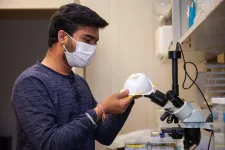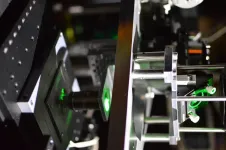(Press-News.org) BRIEFING NOTE: Researchers will announce these results at the 238th AAS meeting on Wednesday, June 9 at 12:15 p.m. E.D.T. Press registration details can be found here: https://aas.org/meetings/aas238/press. Interested journalists can also tune in to AAS briefings streamed live at: https://www.youtube.com/c/AASPressOffice. Please note that you will not be able to ask questions via YouTube; to ask questions, you'll need to register for the meeting and join the briefings via Zoom. Recordings will be archived on the AAS Press Office YouTube channel afterward.
To catch sight of a fast radio burst is to be extremely lucky in where and when you point your radio dish. Fast radio bursts, or FRBs, are oddly bright flashes of light, registering in the radio band of the electromagnetic spectrum, that blaze for a few milliseconds before vanishing without a trace.
These brief and mysterious beacons have been spotted in various and distant parts of the universe, as well as in our own galaxy. Their origins are unknown, and their appearance is unpredictable. Since the first was discovered in 2007, radio astronomers have only caught sight of around 140 bursts in their scopes.
Now, a large stationary radio telescope in British Columbia has nearly quadrupled the number of fast radio bursts discovered to date. The telescope, known as CHIME, for the Canadian Hydrogen Intensity Mapping Experiment, has detected 535 new fast radio bursts during its first year of operation, between 2018 and 2019.
Scientists with the CHIME Collaboration, including researchers at MIT, have assembled the new signals in the telescope's first FRB catalog, which they will present this week at the American Astronomical Society Meeting.
The new catalog significantly expands the current library of known FRBs, and is already yielding clues as to their properties. For instance, the newly discovered bursts appear to fall in two distinct classes: those that repeat, and those that don't. Scientists identified 18 FRB sources that burst repeatedly, while the rest appear to be one-offs. The repeaters also look different, with each burst lasting slightly longer and emitting more focused radio frequencies than bursts from single, nonrepeating FRBs.
These observations strongly suggest that repeaters and one-offs arise from separate mechanisms and astrophysical sources. With more observations, astronomers hope soon to pin down the extreme origins of these curiously bright signals.
"Before CHIME, there were less than 100 total discovered FRBs; now, after one year of observation, we've discovered hundreds more," says CHIME member Kaitlyn Shin, a graduate student in MIT's Department of Physics. "With all these sources, we can really start getting a picture of what FRBs look like as a whole, what astrophysics might be driving these events, and how they can be used to study the universe going forward."
Seeing flashes
CHIME comprises four massive parabolic radio antennas, roughly the size and shape of snowboarding half-pipes, located at the Dominion Radio Astrophysical Observatory in British Columbia, Canada. CHIME is a stationary array, with no moving parts. The telescope receives radio signals each day from half of the sky as the Earth rotates.
While most radio astronomy is done by swiveling a large dish to focus light from different parts of the sky, CHIME stares, motionless, at the sky, and focuses incoming signals using a correlator -- a powerful digital signaling processor that can work through huge amounts of data, at a rate of about 7 terabits per second, equivalent to a few percent of the world's internet traffic.
"Digital signal processing is what makes CHIME able to reconstruct and 'look' in thousands of directions simultaneously," says Kiyoshi Masui, assistant professor of physics at MIT, who will lead the group's conference presentation. "That's what helps us detect FRBs a thousand times more often than a traditional telescope."
Over the first year of operation, CHIME detected 535 new fast radio bursts. When the scientists mapped their locations, they found the bursts were evenly distributed in space, seeming to arise from any and all parts of the sky. From the FRBs that CHIME was able to detect, the scientists calculated that fast radio bursts, bright enough to be seen by a telescope like CHIME, occur at a rate of about 9,000 per day across the entire sky -- the most precise estimate of FRBs overall rate to date.
"That's kind of the beautiful thing about this field -- FRBs are really hard to see, but they're not uncommon," says Masui, who is a member of MIT's Kavli Institute for Astrophysics and Space Research. "If your eyes could see radio flashes the way you can see camera flashes, you would see them all the time if you just looked up."
Mapping the universe
As radio waves travel across space, any interstellar gas, or plasma, along the way can distort or disperse the wave's properties and trajectory. The degree to which a radio wave is dispersed can give clues to how much gas it passed through, and possibly how much distance it has traveled from its source.
For each of the 535 FRBs that CHIME detected, Masui and his colleagues measured its dispersion, and found that most bursts likely originated from far-off sources within distant galaxies. The fact that the bursts were bright enough to be detected by CHIME suggests that they must have been produced by extremely energetic sources. As the telescope detects more FRBs, scientists hope to pin down exactly what kind of exotic phenomena could generate such ultrabright, ultrafast signals.
Scientists also plan to use the bursts, and their dispersion estimates, to map the distribution of gas throughout the universe.
"Each FRB gives us some information of how far they've propagated and how much gas they've propagated through," Shin says. "With large numbers of FRBs, we can hopefully figure out how gas and matter are distributed on very large scales in the universe. So, alongside the mystery of what FRBs are themselves, there's also the exciting potential for FRBs as powerful cosmological probes in the future."
INFORMATION:
This research was supported by various institutions including the Canada Foundation for Innovation, the Dunlap Institute for Astronomy and Astrophysics at the University of Toronto, the Canadian Institute for Advanced Research, McGill University and the McGill Space Institute via the Trottier Family Family Foundation, and the University of British Columbia.
OAKLAND, Calif. -- The significant declines in heart attack hospitalizations and emergency care for possible strokes seen in Northern California at the beginning of the COVID-19 pandemic were not seen in subsequent surges, new research from Kaiser Permanente shows.
The study, published June 2 in JAMA, suggests public health campaigns that encouraged people to seek care if they were experiencing signs or symptoms of a stroke or heart attack were effective.
"In May 2020, we reported that, in the early months of the pandemic, the weekly number of patients admitted to our hospitals for a heart attack fell to nearly half of what would be expected," said the study's lead author Matthew ...
A new study identifies a novel biomarker indicating resilience to chronic stress. This biomarker is largely absent in people suffering from major depressive disorder, and this absence is further associated with pessimism in daily life, the study finds.
Nature Communications published the research by scientists at Emory University.
The researchers used brain imaging to identify differences in the neurotransmitter glutamate within the medial prefrontal cortex before and after study participants underwent stressful tasks. They then followed the participants for four weeks, using a survey protocol to regularly assess how participants rated their expected and experienced outcomes for daily activities.
"To our knowledge, this is the first work to show ...
A new study published in the Journal of the American Geriatrics Society suggests that survival rates after heart transplant surgery are similar in adults ages 18 to 69 and adults ages 70 and older.
Researchers examined a large U.S. database of patients who were listed as candidates for surgery to replace their failing hearts with healthier donor hearts. The researchers found that:
Only 1 in 50 people who are considered for heart transplant surgery and 1 in 50 people who receive a heart transplant are ages 70 or older.
For older adults in the study, the likelihood of surviving one or five years after a heart transplant was about the same as for younger adults.
Having a ...
Early in her career neuroscientist Allyson Mackey began thinking about molars. As a researcher who studies brain development, she wanted to know whether when these teeth arrived might indicate early maturation in children.
"I've long been concerned that if kids grow up too fast, their brains will mature too fast and will lose plasticity at an earlier age. Then they'll go into school and have trouble learning at the same rate as their peers," says Mackey, an assistant professor in the Department of Psychology at Penn. "Of course, not every kid who experiences stress or [is] low income will show this pattern of accelerated development."
What would help, she thought, was a scalable, objective way—a physical manifestation, ...
Even the best face masks work only as well as their fit.
And poorly fitting face masks greatly increase the risk of infection from airborne pathogens compared to custom-fitted masks, according to a new study by the University of Cincinnati.
Researchers in UC's College of Engineering and Applied Science used computerized tomography or CT scans of three different-sized face masks attached to three different-sized dummy heads to measure the gaps between the face and the fabric. Then they calculated the leaks from these gaps to determine the infection risk.
They found that while N95 masks are effective barriers against airborne diseases like COVID-19, poorly ...
Scientists have developed polypeptide-based materials that act as effective vectors for delivering gene therapies. The first-of-its-kind platform enables the vectors to be adapted to suit the specific gene therapy cargo.
The work, led by researchers from RCSI University of Medicine and Health Sciences and funded by Science Foundation Ireland, is published in Biomaterials Science.
A major challenge for gene therapies is preparing them in a way that can deliver the genetic information into the host cells. For the Covid-19 vaccines that use mRNA technology, the genetic information is delivered ...
DARIEN, IL - A study of nearly 2,500 adults found that having trouble falling asleep, as compared to other patterns of insomnia, was the main insomnia symptom that predicted cognitive impairment 14 years later.
Results show that having trouble falling asleep in 2002 was associated with cognitive impairment in 2016. Specifically, more frequent trouble falling asleep predicted poorer episodic memory, executive function, language, processing speed, and visuospatial performance. Further analysis found that associations between sleep initiation and later cognition were partially explained by both depressive symptoms and vascular ...
DARIEN, IL - A 15-year longitudinal study shows that childhood insomnia symptoms that persist into adulthood are strong determinants of mood and anxiety disorders in young adults.
Results show that insomnia symptoms persisting from childhood through adolescence and into adulthood were associated with a 2.8-fold increased risk of internalizing disorders. Insomnia symptoms that newly developed over the course of the study were associated with a 1.9-fold increased risk of internalizing disorders. No increased risk of internalizing disorders was found for those children in whom insomnia symptoms remitted during the study period.
"We found that about ...
MELVILLE, N.Y., June 9, 2021 -- The world is filled with myriad sounds that can overwhelm a person with relentless acoustics. Noise is so prevalent in everyday life that the concept and achievement of comfortable quiet is hard to define.
During the 180th Meeting of the Acoustical Society of America, which will be held virtually June 8-10, Aggelos Tsaligopoulos, from the University of the Aegean, will describe how quiet could be measured in the hopes of better understanding its impact on people. The session, "Towards a new understanding of the concept of quietness," will take place Wednesday, ...
In a major scientific leap, University of Queensland researchers have created a quantum microscope that can reveal biological structures that would otherwise be impossible to see.
This paves the way for applications in biotechnology, and could extend far beyond this into areas ranging from navigation to medical imaging.
The microscope is powered by the science of quantum entanglement, an effect Einstein described as "spooky interactions at a distance".
Professor Warwick Bowen, from UQ's Quantum Optics Lab and the ARC Centre of Excellence for Engineered Quantum Systems (EQUS), said it was the first entanglement-based sensor with performance beyond the best possible existing technology.
"This breakthrough will spark all sorts of new technologies - from better navigation ...



